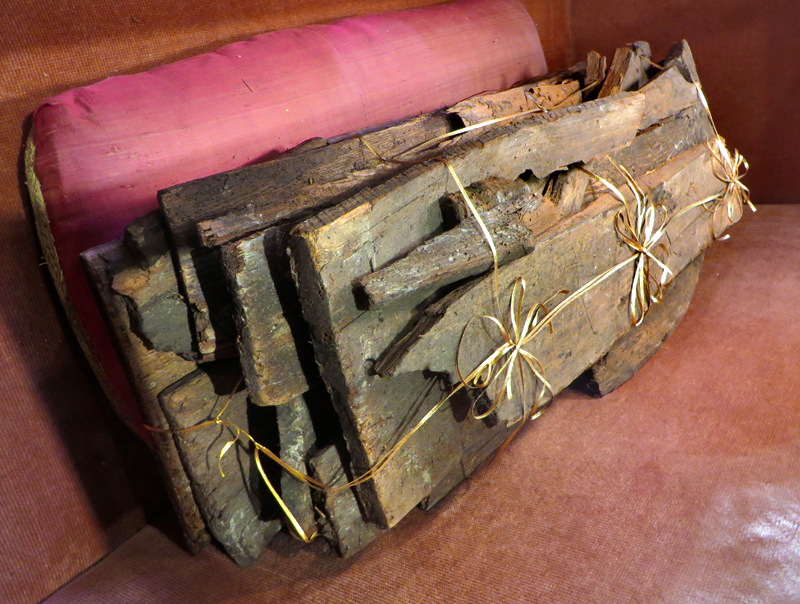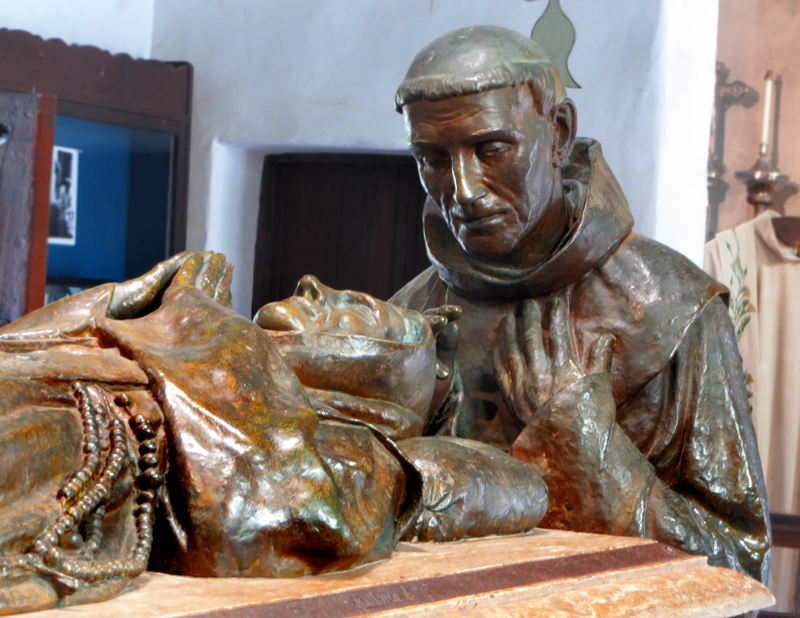|
|
Carmel Mission Basilica
|
May 24, 2014 — Fr. Juniperó Serra cenotaph by sculptor Jo Mora, completed in 1924 at the Carmel Mission. A cenotaph is a monument to an individual whose remains are elsewhere or missing; in this instance, an empty sarcophagus. Serra is interred nearby next to the altar in the basilica. The centaph consists of an empty sarcophagus carved from locally quarried travertine marble with bas-relief panels. A life-size bronze sculpture of Serra lies atop the monument, his bare feet resting on a grizzly bear. Three addtional life-size bronze sculptures by Mora adorn it: Fr. Juan Crespí, who predeceased Serra, stands at the head, praying over him, as if to welcome him into Heaven. Kneeling at Serra's feet are Fr. Fermin Lasuen, who succeeded Serra as the president of the missions of Baja and Alta California; and Fr. Julian Lopez, a friar at the Carmel Mission. Three of the four figures had a significant impact on the Santa Clarita Valley. Serra was founder of the mission system; Crespí named the Santa Clara River Valley when he came through the area with the Portolá expedition in 1769; and Lasuen established the San Fernando Mission in 1797.
Story of the Father Junipero Serra Memorial Cenotaph
In the Mora Chapel Museum, Mission San Carlos Borromeo de Carmelo (Carmel Mission) The Memorial Cenotaph was draped with the flag of Spain, the gold flag of the popes, and the American Stars and Stripes. As each flag was ceremoniously removed — the American flag by the children of the monument's creator, son Joey and daughter Patti — the sounds of the Spanish national anthem filled the air. Moments later, the roll call of representatives from each of California's 21 missions began at 12:30 p.m. on Oct. 12, 1924. In addition to saying a few words in tribute to Father Junipero Serra, the "father of the missions," each representative laid a bouquet of flowers at the foot of Serra's tomb. This festive occasion was the public unveiling of the cenotaph created by Joseph Jacinto Mora (1876-1947) at the request of Father Raymond Mestres, pastor of San Carlos Church in Monterey, as a monumental tribute to Serra. Thus began seven days of pageantry and celebration in honor of the founder of the California missions, Father Junipero Serra. The official dedication of the monument took place four days later on Oct. 16 after participants in the Serra Pilgrimage, dressed in period clothing, traveled over his footpaths from Monterey to Carmel. It can be said that the precipitating moment for these events began almost 140 years earlier in Majorca, Spain, where Serra, a Catalonian, was born. It is no coincidence that Father Mestres was a Catalonian born on the mainland in Spain and that Jo Mora's father was also born in the same area. The Catalonian blood ran deep and was to be the common bond among these three men.
While a student in Spain, Mestres became enamored with the memory of Serra through a Serra family member. His interest never wavered. After his arrival in the United States and his ordination as a priest, he eventually was given the opportunity to take parish duties in Monterey, only a short distance from Serra's burial place. Jo Mora inherited his father's artistic abilities and expansive interest in history as a citizen of the world. After spending his youth in the eastern United States, he traveled west, seeking a first-hand look at the remnants of the founding of the West. This included following the royal road of Father Sera's missions. In 1903, he traveled on horseback from south of the border to Sonoma, exploring, painting and writing about each of the missions. Mestres' opportunity to live in the shadow of the Carmel Mission that he so admired spurred his motivation to inspire the public to look toward restoration of the crumbling mission. Over a period of years, he did research, raised funds and oversaw the plans for the restoration. A permanent monument to Serra as a part of the restoration was one of Mestres' most original ideas. Having seen the sculptural tribute to Cervantes by Jo Mora in Golden Gate Park in San Francisco, Mestres sought an introduction to Mora from the curator of the DeYoung Museum located in the park. In 1920, Mora expressed his enthusiasm for the project in a letter to one of his patrons, Sen. James Phelan of San Francisco: "I am here to 'settle up' one of the most important and interesting commissions I have ever been given. It is to execute the Sarcophagus for Father Junipero Serra and the three Franciscans buried beside him in the Carmel Mission. Could anything be grander for the sculptor who loves California — or fraught with any more romantic and sentimental possibilities? I'm girding my loins for the supreme professional effort in my life." The creation of the cenotaph, a monument without remains, took place on the mission grounds in a workshop Mora built for that purpose. The workshop was close to Mora's new home in Carmel where he had moved his family while he completed the commission. As Mestres shared his vision of the project with Mora, and Mora made models of his own ideas, it became clear that the original idea of placing the monument in the church, above where Serra was actually buried, would result in it having to be smaller than Mora envisioned. So an alternative plan developed. Preparations were already underway to build a small chapel next to the church — it was decided that this would be the perfect setting for the monument. Initially Mora created a small plaster model of the monument. With Father Mestres' approval, it became the stepping stone to a second, full-sized model. Once Mestres gave final approval, Mora shipped the figures off to New York to be cast while he continued to work on the bas-relief elements that decorate the sides of the piece. The finished monument consists of travertine marble and bronze materials. It speaks to a much higher calling because it not only honors Serra, but also depicts several eras of the history of California. In 1922, after spending time with Mora in his mission studio, Edith Daley wrote: "There is an indescribable something about this sculpture of Mora's that speaks the spirit of the days of the padres. The figure of Father Serra — depicting him as he desired to be after death, in his robe, wearing his rosary and with his sandals removed, is done boldly but with artistic perfection of detail. This sculpture of the dead priest holds nothing of coldness that repels. It is as if he slept — after a long hard day of laboring to feed the bodies and save the souls (as Serra perceived it) of the Indians who were his 'children.' The bare feet are not things of shriveled flesh. Each vein stands out as if it still throbbed with the red blood that gave life to the once virile body. And in every feature, in every fold of the robe — there is peace." In 1924, just days before the unveiling, Frank L. Mulgrew articulated his impression of the monument in these words: "The monument, which is in the form of a sarcophagus, commemorates eventful incidents of the labors of Father Serra and symbolizes them in impressive fashion.
"Father Juan Crespí, the friar who accompanied Captain Gaspar de Portolá, military governor of Lower California, when he discovered San Francisco Bay in 1769, stands life-size at the head of the ecclesiastical monument, bending forward in an attitude of veneration and benediction. Father Crespí was the closest associate of Father Serra. "Kneeling at the foot of the tomb is Father [Fermin] Francisco Lasuen, who succeeded Father Serra as president of the missions, and under whose administration the greatest development and glory of the California missions was reached. He is seen to the left, with hands folded across his breast. Father Julian Lopez, a friar at Carmel Mission, who died at the age of 35 years, also kneels at the foot of the monument to the right. Mora has not depicted these standing and kneeling figures with an expression of grief, but has portrayed in their faces that affection found among true churchmen, lightened with religious ecstasy. "The bronze frieze depicts notable events in mission days. At the foot of the sarcophagus is pictured the arrival of the relief ship San Antonio, which was sighted St. Joseph's day, 1770, at San Diego, but did not make port until several days later. This is treated purely allegorically, showing the patron saint of the expedition to Alta California flanked by two angels. In a medallion to one side, Father Serra is kneeling in supplication; in one opposite, the relief ship is portrayed. "Father Sera, accompanying Captain de Portolá, with a body servant and bugler, are included in the first of three panels on the left of the monument, recalling his part in the famous expedition from Lower California to the north, which resulted in the discovery of San Francisco Bay. The second panel shows a squadron of Spanish cavalry, Los Cueras, more familiarly known as the 'leather-packeted troops,' on the march. A pack train, engaged in transportation from mission to mission, occupied the third panel. Franciscan friars are seen in the head panel teaching the Indian neophytes the arts of tilling and sowing. The three panels on the right show the attack by Indians on the San Diego Mission, the mass first celebrated by Father Serra on a rustic altar in Monterey, and the first baptism at Carmel Mission. "An ornamental molding around the entire sarcophagus indicates some of the material benefits that California received from Spain through the agency of the Franciscan friars. Intertwined in this running design are fruits, grains and stock, which includes figs, grapes, oranges, wheat, barley, alfalfa, steers, sheep, goats and pigs. "The sarcophagus is supported by a base 12 feet long and eight feet wide, carrying four inset carvings of three figures each, representing the four groups of men, who stand forth in the conquest and mission days of California.
"Between these inserts are placed medallions of Pope Pius VI and Carlos IV of Spain, who ruled respectively the destinies of church and empire at the time Father Serra passed on to his eternal reward. At the foot of the tomb is the cartouche of the royal coat of arms of Spain, with the Franciscan cord and a garland of California poppies draped over the shield. The four main figures, the historical friezes and the ornamental moldings are cast in bronze. The rest of the tomb is fashioned from California travertine, except the inserts and medallions. These two details are carved in Hauteville marble. In the monument is reflected Catholic and Spanish sentiment, with Father Serra lying in state. The tomb is an expression of tradition and allegory; the figures, convention and purely interpretive." Mulgrew concluded: "When visitors in future ages view Carmel Mission, they will feel the spirit that moved the missionary friars in their service to man and God, a spirit undaunted by worldly peril and hardship. Without understanding the force of this spirit and its celestial significance, it is impossible to comprehend the history of California under Spanish rule." In addition, upon careful inspection, a line of text can be seen along the top edge of the monument. This dedication is written in Spansh as follows: Junipero Serra, hijo legitimo de Antonio Serra y Margarita Ferrer. Nació en Petra, Isla de Mallorca, España, 24 de Noviembre, 1713. Visitó el habito Franciscano 15 de Septiembre 1737. Embarco para los misiones de la Baja y Alta California en el colegio de San Fernando de Mexico 1767. Fundo en la Alta California, nueve misiones. Esta obra fue ideada y llevada a cabo por el Rev. Ramon Mestres y originada y ejucatada en 1924 por el escultor Joseph Mora. Ambos patricios del V.P. Preseidente que murio aqui 1784. R.I.P. Dedicado a la memoria del V.P.T. In English, it reads: Junipero Serra, legitimate son of Antonio Serra and Margarita Ferrer. He was born in Petra, Island of Majorca, Spain, 24 November 1713. He clothed in the Franciscan habit 15 September 1737. He embarked for the missions of Mexico in 1749. He was the president of the missions of Baja and Alta California in the school (college) of San Fernando, Mexico, 1767. He founded nine missions in Alta California. This work was devised and carried out by the Rev. Ramon Mestres and originated and executed in 1924 by the sculptor Joseph Mora. Both patricians of the V.P. President who died here in 1784. R.I.P. Dedicated to the memory of the V.P.T. This then is the story of one of Carmel Mission's most prized points of interest. The heartfelt result of Jo Mora's love of California history, the cenotaph reigns supreme in the mission's Mora Chapel Museum.
19200 dpi jpegs from ditigal images by Leon Worden. |
Story: Rio Santa Clara in Costansó's Diary Perkins Manuscript: Colonization
Junípero Serra (1)
Junípero Serra (2)
Juan Crespí Story
Graves of Serra, Crespí, Lasuen
Serra's Coffin
Serra Cenotaph
Pedro Fages
Fages Marker
Francisco Garcés
Early Afro-Mexican Settlers (Video 2015)
|
The site owner makes no assertions as to ownership of any original copyrights to digitized images. However, these images are intended for Personal or Research use only. Any other kind of use, including but not limited to commercial or scholarly publication in any medium or format, public exhibition, or use online or in a web site, may be subject to additional restrictions including but not limited to the copyrights held by parties other than the site owner. USERS ARE SOLELY RESPONSIBLE for determining the existence of such rights and for obtaining any permissions and/or paying associated fees necessary for the proposed use.
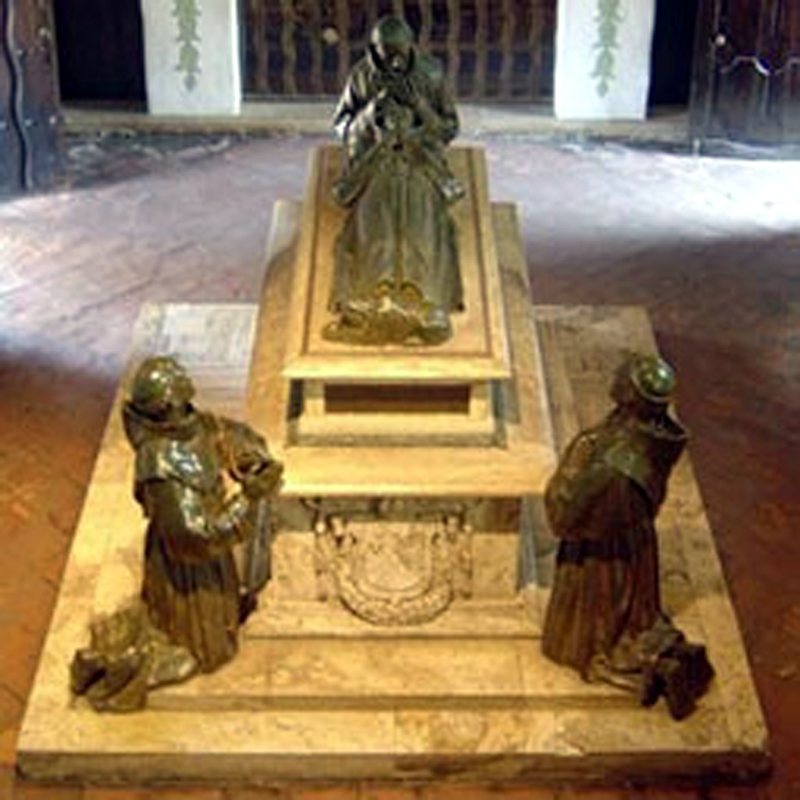 Father Serra was a man of many talents — priest, explorer, agriculturist, stockman, engineer, architect, teacher and lawmaker. His journey throughout Baja and Alta California in the 1770s found him traveling with a cross, not a sword.
Father Serra was a man of many talents — priest, explorer, agriculturist, stockman, engineer, architect, teacher and lawmaker. His journey throughout Baja and Alta California in the 1770s found him traveling with a cross, not a sword.
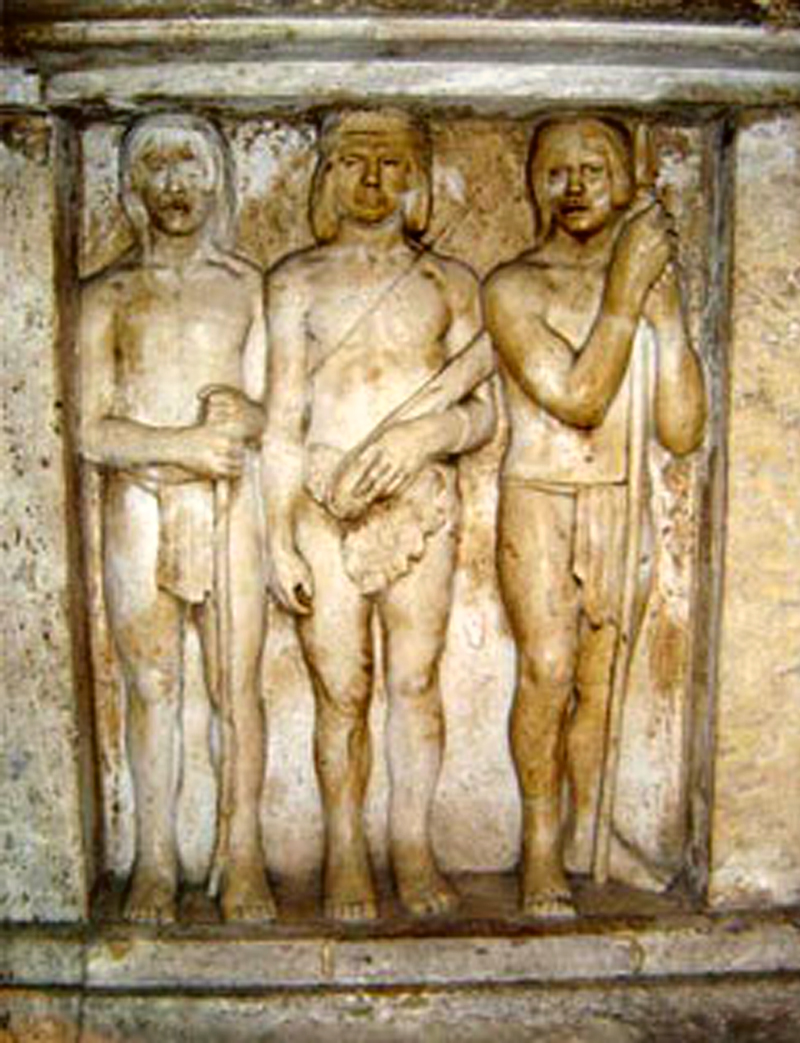 "Father Serra is not represented as in life in the monument, but as in death, which accords with the solemn tradition of the age of the cathedral building. His body, recumbent upon the sarcophagus, is clothed in the Franciscan habit, with stole, crucifix, cord and rosary, as he was prepared for burial, in accordance with his dying request. His feet, bare of sandals, rest upon a grizzly bear cub. This symbol of California replaces the heraldic symbol of fidelity, the dog, or the lion, the insignia of royalty and strength. The cub, like the medieval dog or lion, is treated in the conventional style of the ancient sarcophagi.
"Father Serra is not represented as in life in the monument, but as in death, which accords with the solemn tradition of the age of the cathedral building. His body, recumbent upon the sarcophagus, is clothed in the Franciscan habit, with stole, crucifix, cord and rosary, as he was prepared for burial, in accordance with his dying request. His feet, bare of sandals, rest upon a grizzly bear cub. This symbol of California replaces the heraldic symbol of fidelity, the dog, or the lion, the insignia of royalty and strength. The cub, like the medieval dog or lion, is treated in the conventional style of the ancient sarcophagi.
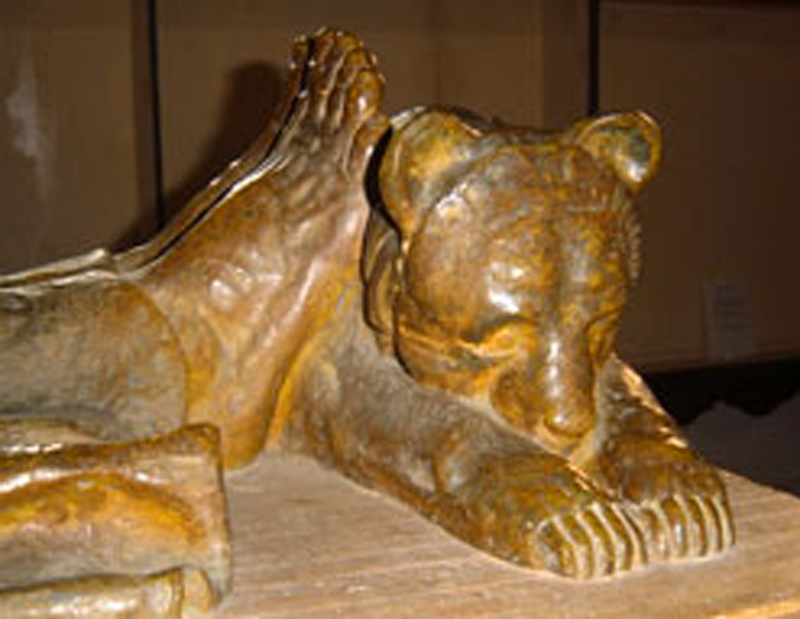 "These groups are the Franciscan friars, who developed and perfected the work begun by the expelled Jesuits from Lower California; the Spanish soldiers, who were employed to repel savage marauders; the neophytes, or Indian converts to Christianity, who tilled the soil about the missions; and lastly, the wild Indians — or gentiles, as they were called by the friars — who were gradually conquered, less by force of arms than by the power of Christian love.
"These groups are the Franciscan friars, who developed and perfected the work begun by the expelled Jesuits from Lower California; the Spanish soldiers, who were employed to repel savage marauders; the neophytes, or Indian converts to Christianity, who tilled the soil about the missions; and lastly, the wild Indians — or gentiles, as they were called by the friars — who were gradually conquered, less by force of arms than by the power of Christian love.




